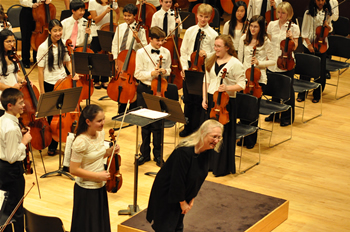Classical music is alive and kicking if the fifty-some teenaged musicians of the Winston-Salem Symphony Youth Symphony, on-stage at the Stevens Center in downtown Winston-Salem, have anything to say about it! The standing ovation of parents, friends, and the musically curious was testimony that the message was heard loud and clear: young musicians are flourishing and are championing the music they love!
To be sure, there is still some room for improvement – patience, control and stability are virtues most often associated with experience and maturity. But the raw materials of music – enthusiasm, expressiveness and technical mastery of instrumental skills – were all present in abundance. Much credit must go the young conductor who wisely chose a program tailored to the strengths of the musicians, Music Director Stephen Mulligan, who also serves as the assistant conductor of the Winston-Salem Symphony. Standing square-jawed and short with fists jutting into the air, Maestro Mulligan reminded me of photos of the legendary Willem Mengelberg. He led his young musicians with authority and humor as the ripple of smiles through the string sections at critical moments suggested.
The concert opened with the first movement (Prelude) of Max Bruch’s elegant and romantic Violin Concerto No. 1, Opus 26, in G minor. The young soloist was Emilia Sharpe, winner of the youth orchestra’s Concerto Competition, and an eight-year veteran of the Youth Symphony. Miss Sharpe, currently enrolled as a high school student at the prestigious University of North Carolina School of the Arts, has a lovely warm expressive tone and mostly excellent intonation. Ending as it begins, with the soloist building elaborate arpeggios over a long-held open “G,” the orchestra was able to give a credible conclusion to the movement which usually serves as a prelude to the following slow movement.
The only other work on the program was the lovely Symphony No. 8, Opus 88, in G, Antonín Dvořák’s happiest symphony. Using themes from nature (opening bird call) and folk tunes from Bohemia and nearby Moravia, Dvořák weaves a subtly interconnected web of cheerful tunes. Except for a raucous series of modulated sequences in the Finale, elegance is the mot du jour, especially the lovely lilting waltz-like third movement Allegretto grazioso and its Two-Step coda.
For the most part, the performance was excellent, a flat woodwind here, an over-zealous horn there, and a wandering lower wind which quickly found itself; but also lovely clarinets, strong rhythmic trumpet, dynamic horns and sterling tympani as well as the warm burnished sound of the strings, characteristics of a well-trained and self-disciplined orchestra. This orchestra has made tremendous progress this year, and despite the departure of several graduating seniors, it is poised to make even more progress next year. Congratulations to parents, volunteers, Maestro Mulligan, and especially to the young musicians themselves!













